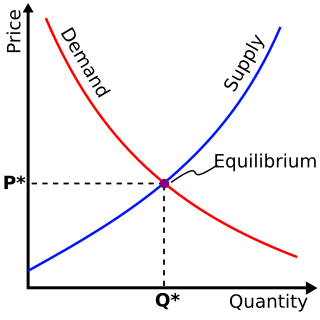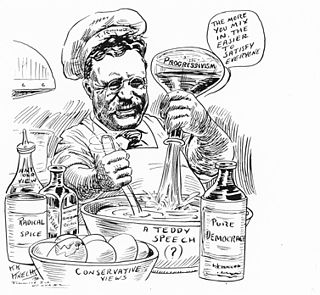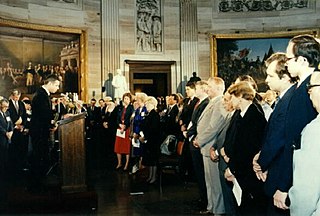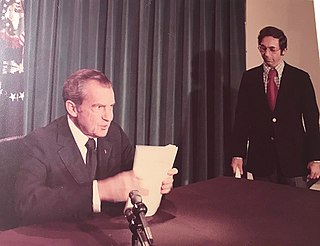
Gross domestic product (GDP) is a monetary measure of the market value of all the final goods and services produced and rendered in a specific time period by a country or countries. GDP is often used to measure the economic health of a country or region. Several national and international economic organizations maintain definitions of GDP, such as the OECD and the International Monetary Fund.

Charles William Eliot was an American academic who was president of Harvard University from 1869 to 1909, the longest term of any Harvard president. A member of the prominent Eliot family of Boston, he transformed Harvard from a respected provincial college into America's preeminent research university. Theodore Roosevelt called him "the only man in the world I envy."

The Gun Control Act of 1968 is a U.S. federal law that regulates the firearms industry and firearms ownership. Due to constitutional limitations, the Act is primarily based on regulating interstate commerce in firearms by generally prohibiting interstate firearms transfers except by manufacturers, dealers and importers licensed under a scheme set up under the Act.

An Inquiry into the Nature and Causes of the Wealth of Nations, generally referred to by its shortened title The Wealth of Nations, is the magnum opus of the Scottish economist and moral philosopher Adam Smith (1723–1790). First published in 1776, the book offers one of the world's first connected accounts of what builds nations' wealth, and has become a fundamental work in classical economics. This is the first formulation of a comprehensive system of political economy. Reflecting upon economics at the beginning of the Industrial Revolution, Smith addresses topics such as the division of labour, productivity, and free markets.

The Second Bill of Rights or Bill of Economic Rights was proposed by United States President Franklin D. Roosevelt during his State of the Union Address on Tuesday, January 11, 1944. In his address, Roosevelt suggested that the nation had come to recognise and should now implement a "Second bill of rights". Roosevelt argued that the "political rights" guaranteed by the Constitution and the Bill of Rights had "proved inadequate to assure us equality in the pursuit of happiness". His remedy was to declare an "economic bill of rights" to guarantee these specific rights:
John Adams' Second State of the Union Address was delivered on Saturday, December 8, 1798, in the Congress Hall of Philadelphia, Pennsylvania. Adams compares the sickness affecting various coastal cities in 1797 to the dispensations of the Tribulation. He called upon the Congress to pass public health laws to prevent the spread of disease through interstate commerce. He also suggests the establishment of "a system which, while it may tend to preserve the general health, may be compatible with the interests of commerce and the safety of the revenue."

Ellis Henry Roberts was an American politician who served as a Representative from New York and 20th Treasurer of the United States.

The first inauguration of Franklin D. Roosevelt as the 32nd president of the United States was held on Saturday, March 4, 1933, at the East Portico of the United States Capitol in Washington, D.C. This was the 37th inauguration, and marked the commencement of the first term of Franklin D. Roosevelt as president and John Nance Garner as vice president.

Theodore Roosevelt (1858–1919) was the 26th President of the United States (1901–1909) and also served as Governor of New York and Vice President. He is known for becoming a leading spokesman for his version of progressivism after 1890. However, author Daniel Ruddy argues in his book Theodore the Great: Conservative Crusader that Roosevelt was actually a "populist conservative" and a "Hamiltonian"—a conservative in the eighteenth century sense of the word. Similarly, Francis Fukuyama identifies Roosevelt, together with Alexander Hamilton, as part of a tradition of a strong-state conservatism in the United States.

The Moral Equivalent of War speech was a televised address made by President Jimmy Carter of the United States on April 18, 1977.

The Days of Remembrance of the Victims of the Holocaust (DRVH) is an annual eight-day period designated by the United States Congress for civic commemorations and special educational programs that help citizens remember and draw lessons from the Holocaust. The annual DRVH period normally begins on the Sunday before the Israeli observance of Yom HaShoah, Holocaust Memorial Day, and continues through the following Sunday, usually in April or May. A National Civic Commemoration is held in Washington, D.C., with state, city, and local ceremonies and programs held in most of the fifty states, and on U.S. military ships and stations around the world. The United States Holocaust Memorial Museum designates a theme for each year's programs, and provides materials to help support remembrance efforts.

The 2013 State of the Union Address was given by the 44th president of the United States, Barack Obama, on February 12, 2013, at 9:00 p.m. EST, in the chamber of the United States House of Representatives to the 113th United States Congress. It was Obama's fourth State of the Union Address and his fifth speech to a joint session of the United States Congress. Presiding over this joint session was the House speaker, John Boehner, accompanied by Joe Biden, the vice president, in his capacity as the president of the Senate.

On August 8, 1974, U.S. President Richard Nixon delivered a nationally-televised speech to the American public from the Oval Office announcing his intention to resign the presidency the following day due to the Watergate scandal.
The 1926 State of the Union Address was given by Calvin Coolidge, the 30th United States President, on Monday, December 6, 1926, to the United States House of Representatives, and the United States Senate. It was his fourth State of the Union Address and was delivered to the Congress in written format.
The 1906 State of the Union Address was written by Theodore Roosevelt, the 26th president of the United States, on Monday, December 3, 1906. He did not speak directly to the 59th United States Congress. He said, "The readiness and efficiency of both the Army and Navy in dealing with the recent sudden crisis in Cuba illustrate afresh their value to the Nation. This readiness and efficiency would have been very much less had it not been for the existence of the General Staff in the Army and the General Board in the Navy; both are essential to the proper development and use of our military forces afloat and ashore."
The 1901 State of the Union Address was given on Tuesday, December 3, 1901, by the 26th president of the United States, Theodore Roosevelt. It was presented to both houses of the 57th United States Congress, but he was not present. He stated, "The Congress assembles this year under the shadow of a great calamity. On the sixth of September, President McKinley was shot by an anarchist while attending the Pan-American Exposition at Buffalo, and died in that city on the fourteenth of that month." He concluded it with, "Indeed, from every quarter of the civilized world we received, at the time of the President's death, assurances of such grief and regard as to touch the hearts of our people. In the midst of our affliction we reverently thank the Almighty that we are at peace with the nations of mankind; and we firmly intend that our policy shall be such as to continue unbroken these international relations of mutual respect and good will."
The 1862 State of the Union Address was written by the 16th president of the United States, Abraham Lincoln, and delivered to the 37th United States Congress, on Monday, December 1, 1862, amid the ongoing American Civil War.
The 1951 State of the Union Address was given by Harry S. Truman, the 33rd president of the United States, on Monday, January 8, 1951, to the 82nd United States Congress in the chamber of the United States House of Representatives. It was Truman's sixth State of the Union Address. Presiding over this joint session was House speaker Sam Rayburn, accompanied by Vice President Alben W. Barkley in his capacity as the president of the Senate.
The 1905 State of the Union Address was submitted on December 5, 1905, by the 26th president of the United States. This was Roosevelt's fifth address.
The 1919 State of the Union Address was written by the 28th president of the United States, Woodrow Wilson, on Tuesday, December 2, 1919.












